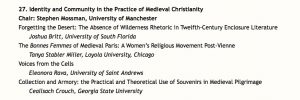http://www.newcollegeconference.org/program
Recluses were separated but not excluded from the community that hosted them. While the hermit, being free, could provide for him or herself, an urban recluse depended on others to survive, existing in an osmotic relationship with civic and ecclesiastical communities. In virtue of the purity acquired through the ceremony of imprisonment (and staying-power), a recluse might acquire the role of mediator of divine grace, dispensing consolation and pious counsel. Taking responsibility for the sins of the community, she atoned for them by the rigours of penance, embodying a sacred presence and exemplifying a different way of living. The cell could also be a means for women to break out of conventional roles, becoming a kind of speakers’ corner, a place to hear and debate: the cell enabled women’s voices in public, countering Paul’s message in 1 Cor. 14:34 that they were to be silent in churches.
This ability to speak is particularly evident in the case of Margaret the Lame who gave lessons from her cell in the main square of Magdeburg: she summed these up in salient points that were easily memorizable, such as the five qualities of the good christian, the seven torments of hell, the twelve attributes of the Trinity, and so on. But there also some sensational cases in documentary sources, such as that of a recluse who promoted ‛heretical’ ideas from a cell, or that of a recluse, who testified in court against the patron of her cell, who had tried to abuse her.
The specific objective of the paper is to understand the role and the power of women in a cell. To what extent and why did withdrawing to a cell allow women to act and to speak? How permeable were the cell walls? What sort of relations developed between recluses and the urban society from which they ‛withdrew’? What role did recluses play in the public, religious and ecclesiastical life of different urban and political realities? What determined these relations?

